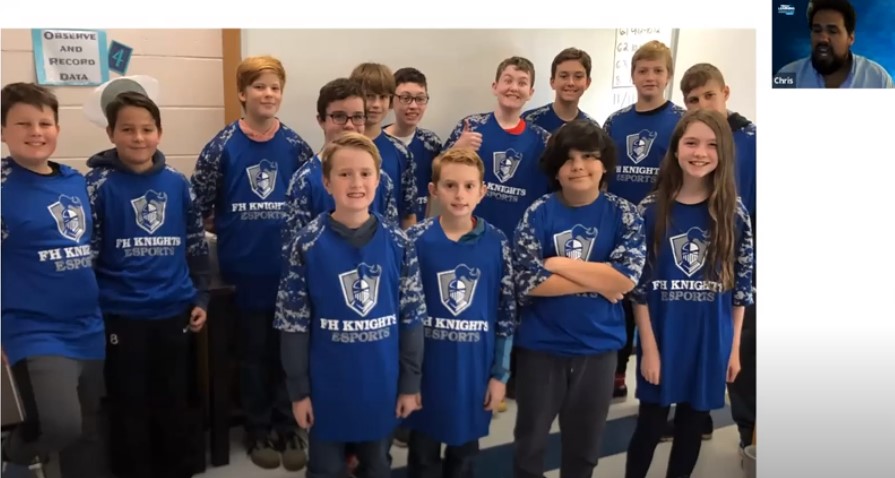How to Connect Students Virtually through Esports
Schools use esports programs to create opportunities for diversity and inclusion, teach students a variety of coveted skills, and prepare students for college and career

Esports can be transformative for every student in the school, according to James O’Hagan, director of digital and virtual learning for Racine Unified School District in Wisconsin.
“Start with the ecosystem around esports, which is broader than the focus on games, players, and equipment,” O’Hagan said. “Think beyond the games. It’s not just a STEM activity. There are other benefits, such as developing social-emotional skills for health and wellness.” He recommended that the students on the team represent and reflect the cross-section of students in the school.
O’Hagan made his comments during Tech & Learning’s recent Virtual Leadership Summit, as part of a lively panel featuring esports educators who discussed issues around esports, including equity.
Watch the full session
O’Hagan also recommended taking what kids are doing and combining it with how you want to teach, and to be clear about what you want to accomplish.
In Racine the goals were to:
- Redefine the athletic culture
- Increase student participation opportunities through diversity
- Increase college and career pathways
- Promote good physical and mental health
- Honor the importance of play
- Support the district’s strategic goals through esports
Choosing Diversity and Inclusion
Former middle school teacher Carrie Linden is an advocate for esports. Her focus is on diversity and inclusion—making programs inclusive so they represent the student population. During the session, she said that the games environment is quite broad with content creation, production, management, and coaching opportunities. Building these aspects into your program allows for a wider array of student interest. Not all kids self-identify as gamers, so it’s important to build a diverse and inclusive program, she said.
Tools and ideas to transform education. Sign up below.
“Although Fortnite has been allowed in many schools, many third-party shooter games are not allowed,” Linden said. “Look for alternative titles, such as Minecraft, to make the games diverse.”
Real diversity is a commitment. “Just letting someone show up does not mean that you are
creating an environment that makes them comfortable—girls or LGBTQs, for example,” Linden said.
Linden advises schools to look at what kids are playing and to make sure their program reflects that. “Put in the time to do your research, change, and adapt as you need to,” she said. Make different demographics more visible when marketing your program.
“Everywhere you’re promoting, do student surveys,” Linden said. A pool of students who aren’t getting their needs met might exist, and surveys will allow you to learn why not. Ask questions, such as:
- What do you play?
- How long do you play?
- Who do you play with?
- Why haven’t you joined the esports club/team?
Finding and Working with Partners
Chris Aviles, edtech coach at Fair Haven (NJ) Schools, started his first middle school esports team three years ago. They didn’t have any competitors in the area so Aviles reached out to Rutgers University, and they played several matches. The middle schoolers began chatting with the college players in a Skype call after the game was over, and asked about what the college students were studying, what their career goals were, and more.
“Esports is one of the fastest-growing industries in the world,” Aviles said. “We keep talking about STEM jobs, and here is a perfect opportunity to learn STEM skills.” He appreciated that the Rutger students took time to mentor his middle schoolers.
“My kids can follow their gaming passion right through high school and college,” he said. “There are also more traditional jobs within the esports world; it’s not just gamers.”
Aviles’ students were also able to talk to Stockton University’s esports players and about career paths. Some students self-identify as gamers but others are not sure about it. On a campus tour of Stockton, who had recently partnered with the Army, the middle schoolers were able to see a career path into the Army.
“Adults dismiss gaming too easily,” said Aviles. “It is not a waste of time. Find a way to validate what kids are doing.” Aviles pointed out that there are kids with physical or learning disabilities that keep them from playing regular sports who would be interested in esports.
“It’s important to keep in mind that more than anything, esports is about making kids feel like they belong to something,” he said. “Gaming doesn’t have to be toxic. We are educating the whole student and using social-emotional skills to build them up.”
Considering the Benefits of Collegiate Esports
Mark Deppe is the director of the esports program at the University of California Irvine. College esports began in 2014 at Robert Morris University in Chicago which is now Roosevelt University.
Now, there are more than 200 schools that offer scholarships for esports—competitive and non-competitive. Deppe outlined important benefits to college esports:
- Competition is the central pillar. Colleges offer scholarships and coaching opportunities.
- Promoting academics and research with high school and college practitioners.
- Making the world a better place by building diversity, outreach, and elevating women in games.
- Piloting bystander intervention training—how to engage with problematic behavior.
- Content creation and entertainment. Show casting, podcasting, play by play roles.
- Career development. Resume building support, networking nights with the industry, taking raw talent and polishing it.
Deppe concluded by saying that esports provides opportunities for skill building and this helps schools send students out into the world to be the people we want them to be.
Annie Galvin Teich has more than 25 years' experience in education writing and publishing. She is an edtech industry expert in content marketing and copywriting. As a regular contributor to Tech & Learning she focuses on the information needs of district decision makers.
